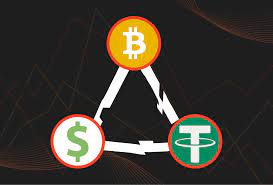The Crypto Market Tug-of-War: Bullish and Bearish Catalysts, Market Trends, and Future Predictions
1. Introduction
The cryptocurrency market has been caught in a tug-of-war between bullish and bearish catalysts in recent times. Global events, market patterns, and the role of stablecoins have all contributed to shaping the market’s direction. As we navigate this uncertain landscape, understanding these factors and potential future trends is crucial for investors, traders, and developers alike.
2. The US Government Debt and Market Implications
Janet Yellen recently warned that the US government could default on its debt as soon as June 1st. While this might sound like fear-mongering, there is some substance to this claim. US government debt, also known as US bonds, backs trillions of dollars of loans and is used for trillions of dollars of transactions both within and outside the United States. If the US government were to miss a payment date on some of these bonds, it would call the quality of this collateral into question and potentially shake the very foundations of the global financial system.
A similar situation occurred in 2011 when the US government nearly defaulted on its debt due to political disagreements over the debt ceiling. This event caused the stock market to crash by almost 20% and resulted in US government debt being downgraded for the first time, making it lower quality collateral. The current political divide may lead to a similar outcome, which could negatively impact markets, including cryptocurrencies.
3. Debt Ceiling Deal and Market Consequences
Even if US politicians manage to agree on a debt ceiling deal, it could still spell bad news for the markets. The US Treasury will start to issue US government debt once again, pulling around $500 billion out of the markets and into government debt. This, combined with the Federal Reserve’s shrinking balance sheet, will result in a sharp contraction in market money supply, hitting risk assets like cryptocurrencies the hardest.
However, this effect may be short-lived. If the Fed is forced to pivot due to a banking crisis, an upcoming commercial real estate crisis, or an unforeseen event, risk assets like cryptocurrencies could rebound stronger than ever. This means the crypto market will continue to be caught between bullish and bearish catalysts, potentially moving sideways until a clear direction is established.
4. Analyzing Market Patterns: Bitcoin and Ethereum
According to Valkyrie Investments, Bitcoin has been painting a head and shoulders pattern on the daily chart. This pattern suggests that Bitcoin could correct down to $25k in the short term. A similar pattern was observed on Ethereum’s price chart, but its recent price action seems to have invalidated the pattern.
Last week’s price action has thrown a wrench into the Bitcoin and Ethereum trends, making it difficult to predict the market’s short-term direction. As the market continues to be influenced by global events and market forces, investors and traders need to stay informed and adapt their strategies accordingly.
5. The Role of Stablecoins in the Crypto Market
Stablecoins have played a crucial role in the crypto market, with Tether’s USDT and Circle’s USDC competing for dominance. As these stablecoins navigate the changing regulatory environment and market demands, their impact on the overall crypto market cannot be underestimated. Understanding the role of stablecoins in the current market landscape and their potential future growth is essential for market participants.
6. Regulatory Landscape and Its Impact on Cryptocurrencies
Regulators worldwide have been closely monitoring the cryptocurrency space, and their actions have a significant influence on market dynamics. In the United States, regulators have been tightening their grip on stablecoin issuers, which could impact the growth of USDC and other stablecoins. Meanwhile, foreign regulators have been taking aggressive steps to deter the continued use of cryptocurrencies, as seen in countries like Argentina and Nigeria.
In Argentina, the central bank has reportedly banned crypto payment apps, citing a desire to separate the payment system from the digital asset ecosystem. This move may be related to the country’s recent debt deal with the International Monetary Fund (IMF), which required Argentina to discourage the use of cryptocurrencies in exchange for receiving USD support.
Nigeria, on the other hand, has introduced digital asset regulations that explicitly exclude cryptocurrencies. This indicates that the country’s tokenized assets will likely be issued on centralized and permissioned blockchains. As more countries adopt centralized digital currencies (CBDCs), coercion and restriction of cash use may become more common, as seen with Nigeria’s e-Naira.
7. The Importance of Digital ID for CBDCs
The implementation of digital ID systems plays a crucial role in the adoption of CBDCs, as they are required for these digital currencies to function. Countries that adopt digital ID systems may be signaling their intent to introduce CBDCs, as seen in Nigeria prior to its e-Naira rollout. Market participants should keep an eye on digital ID developments, as they could indicate upcoming shifts in government policy toward cryptocurrencies.
8. The Future of the Cryptocurrency Market
The cryptocurrency market is likely to remain volatile and uncertain as it continues to be influenced by a multitude of factors, including global events, regulatory developments, and market patterns. Investors and traders should remain vigilant and adaptable, closely monitoring market trends and adjusting their strategies accordingly.
In the short term, the market may continue moving sideways as bullish and bearish catalysts vie for dominance. However, as the global financial landscape evolves and the potential for disruption from cryptocurrencies becomes more apparent, the market could experience significant shifts that create new opportunities for growth and innovation.
Conclusion
Understanding the current state of the cryptocurrency market and the tug-of-war between bullish and bearish catalysts is essential for investors, traders, and developers alike. By staying informed about global events, market patterns, the role of stablecoins, and the impact of regulations, market participants can make more informed decisions about their investments and strategies in this rapidly changing landscape.






